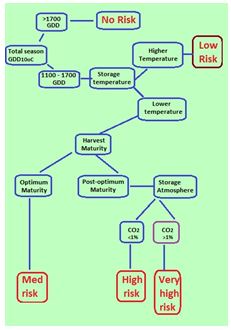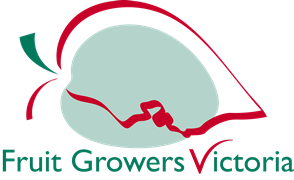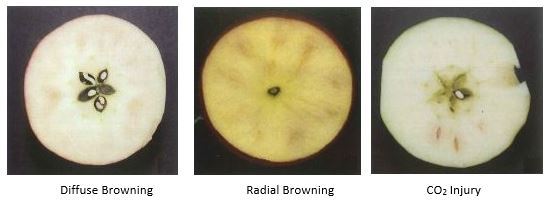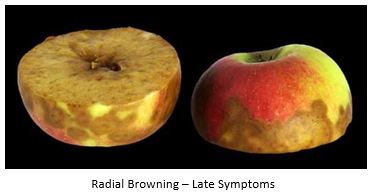Postharvest Browning of Apples
Low Crop Load or Late Harvest
Storage diseases are damage to fruit, which are not yet visible during the harvest and appear only during or after storage. These diseases are divided into two types:
- Parasitic Diseases - Caused by microorganisms such as fungi or bacteria; and
- Physiological diseases - resulting disturbances of metabolism, without the intervention microorganisms.
Some of growers have reported that a great percentage of apple fruit in the cool room can show symptoms of internal browning. According to them, this problem cannot be predicted because it appears every year on different blocks of tree regardless of the same technology applied during the production.
Many packers have reported significant levels of internal browning in apples from orchards previously free of this disorder. Apparently, unknown preharvest factors cause fruit to be more prone to internal browning in some years and orchards than others.
The flesh of apples in a cool room becomes brownish and this may extend to the whole fruit according to the degreeof the disease. The damage is usually invisible from the outside, therefore preharvest and postharvest inspections need to be done.
Flesh browning is a result of different pre- and post-harvest factors such as CO2 injury, chilling injury, nutrient deficiency or senescent breakdown. Another important seasonal predictor is the accumulated growing degrees-days(GDD) above 10⁰C from full bloom to harvest.
The GGD is a mathematical calculation of the number of hours per day above 10⁰C, this is an indication of how warmor cold a season has been. Each variety of apple has a different GDD and therefore internal browning appears at different seasonal conditions and fruit maturity.
Internal browning in Breaburn apples can develop in regions with less than 1300 GDD above 10⁰C from full bloom to harvest. According to some research findings, cool growing conditions may alter cellular metabolism, reduce skin and tissue diffusivity and/or increase fruit susceptibility to elevated CO2 and low O2.
In contrast, flesh browning in Fuji apples is usually the result of CO2 injury. Fuji apples are more sensitive to high CO2 than any other apple varieties (Rees, 2012). The susceptibility to CO2 damage in Fuji apples can be predicted from a sample of fruit held at 20⁰C at 20% CO2, then flesh browning symptoms are observed in susceptible fruit after three days.
In Cripps Pink apples, there are three types of flesh browning disorders. The first is a CO2 injury. This kind of injury is aggravated by controlled atmosphere (CA) conditions with increasing levels of CO2 and decreasing levels of O2. CO2 injury in Cripps Pink has been identified by the formation of lens shaped pits and cavities through the cortex tissue of the fruit.
The second type of flesh browning is called Radial Flesh Browning which is aggravated by low seasonal temperatures, late harvest, low storage temperatures and elevated CO2 in CA storage. Radial browning is characterized by browning of the tissue adjacent to the vascular bundles, with the cortex tissue remaining unaffected. This is the complete opposite pattern compared to diffuse browning. The small vascular cells are thought to limit the diffusion of CO2 through the fruit, leading to a build up of toxic quantities of CO2 aggravating the senescent disorder. A higher area of browning is found at the stem end of the fruit, with decreasing levels found toward the calyx end of the fruit.
The third type of flesh browning is called Diffuse Flesh Browning and this disorder is reported to be the result of chilling injury. Diffuse browning is characterized by browning of the cortex tissue, caused by the collapse of cells with the vascular tissue remaining unaffected. Cortex cells are larger and have thinner cell walls compared to the vascular cells and therefore more prone to collapse resulting from chilling injury which leads to development of the characteristic browning. A higher area of browning is found at the stem and calyx ends of the fruit, with less in the middle of the fruit (Bergman et al. 2012).
The most common type of browning in Australia is a Radial Flesh Browning, whereas Diffuse Flesh Browning is seen in New Zealand and Europe.
It has been found that seasonal climatic conditions, influence the development of these three types of flesh browning in Cripps Pink (Rees, 2012). The critical periods at this stage appear to be the first 50 days after full bloom (DAFB) with cooler seasons promoting the development to denser fruit. This can increase the risk of fruit developing Radial Flesh Browning in storage. Seasonal accumulated GDD have also been related to the development of storage disorders of the apple varieties. For Cripps Pink grown in Australia, fruit in season of districts with accumulated GDD below 1200 appear to be susceptible to diffuse flesh browning. In areas or seasons where the accumulated GDD are between 1200 and 1500, the fruit are susceptible to radial flesh browning, all fruit are susceptible to CO2 injury if exposed to high levels of CO2 in storage (Rees, 2012).
Fruit nutrition has also been found to influence the development of radial browning in Cripps Pink apples. Incidence of radial browning was found to increase with decreasing crop load and associated decrease in calcium concentration.
Harvest maturity is another important orchard factor that can influence the development of radial browning. Llate harvested fruit have been shown to result in an increased incidence of radial browning during storage, it is important to monitor orchards with regular samples to accurately predict optimum harvest maturities. The determination of optimal maturity is often based on a number of harvest indices including starch
pattern index, skin colour, flesh firmness, internal ethylene concentration, respiration rate, soluble solids and date; however, these are specific to cultivar, season and growing region.
When apples are harvested multiple times to optimize color, size and flavor, interior fruit - generally the least mature on the tree - is the last to be picked, packers had observed that late-harvested lots showed more internal browning.
Fruit maturity at harvest is of particular concern for ‘Cripps Pink’ apples as major Australian supermarkets have set a high specification of red blush (60%). This high specification often resulted in fruit being harvested over mature as growers were forced to delay harvest in an attempt to increase the level of red colouring on the skin of the fruit. By delaying harvest, the risk of developing radial browning during storage is increased, negating some of the positive qualities of this cultivar. As a result of the findings of the link between fruit maturity at harvest and flesh browning, Australian retailers have reduced the percentage of red blush specifications to 45-50% which is an important difference for growers (James et al., 2005).

Prevention of diffuse browning, radial browning and CO2 injury development:
- It is recommended that calcium levels are adequate during fruit growth and development and that the tree crop load is maintained at an adequate level.
- It is recommended that the best commercial practices for harvest maturity are employed and that fruit are harvested and placed in ideal storage conditions prior to the ethylene climacteric.
- It is recommended that the concentration of CO2 in controlled atmosphere storage is kept below 1% to reduce the likelihood of the fruit developing internal CO2 injury.
- In years of higher suspected risk (<1100GDD) fruit should not be stored longer than 4 months under CA conditions (Bergman et al. 2012).
Seasonal data could be used to predict the incidence of flesh browning by relating the seasonal GDD to the incidence of actual occurrence of the disorder. The progress of the season can be plotted and the potential risk can be seen prior to harvest and appropriate marketing and storage strategies put in place. GDD values vary depending on area and season. The calculation of growing degree days (GDD) can be done by taking the average of daily maximum and minimum temperatures compared to a base temperature (10⁰C). This can be presented as an equation:

Total Seasonal GDD = ∑post bloom (Daily GDD)
The total seasonal GDD is the sum of the daily GDD from full bloom until harvest. GDD is calculated on a base temperature (Tbase) of 10⁰.
Recommendations
For optimal long term storage and control of the radial flesh browning disorder, ‘Cripps Pink’ apples grown in regions accumulating greater than 1100 GDD10°C should be stored at 1⁰C for a maximum period of 9 months. Harvest maturity was shown to increase the risk of ‘Cripps Pink’ apples developing radial flesh browning during storage, consequently it is recommended that best commercial practices for harvest maturity are employed and that fruit are harvested and placed into ideal storage conditions prior to the ethylene climacteric. It is recommended that ‘Cripps Pink’ apples are harvested at an SPI of 3.5 (CTIFL chart, Centre Technique Interprofessionnel des Fruits et Légumes, France). It is also recommended that calcium levels are adequate during fruit growth and development and that the tree crop load is maintained at an adequate level. The addition of CO2 to the storage atmosphere was also found to detrimentally effect the development of the radial flesh browning disorder. It is recommended that the concentration of CO2 in the storage atmosphere is kept below 1% in order to reduce the likelihood of the fruit developing both radial flesh browning and internal CO2 injury (Jobling, Jenny, 2008).
Petar Bursac, Industry Development Officer, Fruit Growers Victoria
References
- Bergman H., Crouch E.M., Crouch I.J., Jooste M.M., Majoni T.J. (2012), Update On the Possible Causes and Management Strategies Of Flesh Browning Disorders In 'Cripps' Pink' Apples, Stellenbosch University, South Africa
- Bitter Pit of Apples. University of California Cooperative Extension Publication, Division of Agricultural Sciences, Leaflet 2712, 1975.
- Debbie Rees (2012): Crop Post-Harvest: Science and Technology, John Wiley & Sons, Inc. UK
- Integrated Pest Management for Apples and Pears. University of California, Division of Agriculture and Natural Resources, Publication 3340, 1991. ISBN 0-931876-94-X, Library of Congress Catalog Card No. 91-65337.
- James, H., J. Jobling, and D. Tanner (2006). Investigating structural and physiological differences between radial and diffuse types of flesh browning of Cripps Pink apples. Proceedings of the 27th International Horticultural Congress. In Press.
- Jobling, Jenny (2008), Managing the Flesh Browning Disorder of Cripps Pink Apples, Bundeena, N.S.W.: Applied Horticultural Research.



